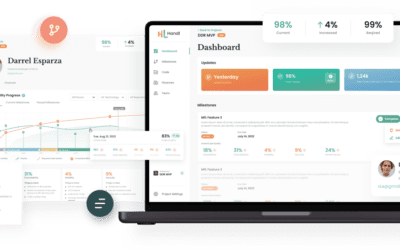Building a successful app isn’t just about a killer idea and sexy design. It’s about laying a solid foundation that’s built on the right programming languages, frameworks, and tools.
The only issue is that there’s a virtually infinite amount of configurations between all of the tools and technologies available. So how do you choose the right combo?
This is a rather loaded question with no one-size-fits-all answer. It really comes down to what you’re trying to build—that’s what’s going to guide you toward the right tech. You could say it’s a “choose your own adventure” sort of undertaking.
So while we definitely can’t tell you right now what should be in your tech stack, what we can do is go over some of the top considerations and details to think about as you decide.
First things first: What is a tech stack?
In app development, a tech stack refers to the combined set of technologies used to build and run a mobile or web application. It’s like a toolbox that contains programming languages, frameworks, libraries, databases, servers, APIs (application programming interfaces), and other tools that developers use to bring your app to life.
Think of it this way: your app is a building, and the tech stack is the collection of bricks, mortar, tools, and blueprints used to construct it. Each component plays a specific role in shaping your app’s functionality, performance, and user experience.
Core components of an app’s tech stack
Let’s quickly break down the pieces of a tech stack and what they mean.
Front-end
This is what users see and interact with directly, including the user interface (UI) and user experience (UX). Key components include:
- Programming languages. For web apps, HTML, CSS, and JavaScript are common foundations, but frameworks like React or Angular can accelerate development. For mobile apps, popular choices include Kotlin and Java for Android, Swift for iOS, and JavaScript frameworks like React Native and Flutter for cross-platform development.
- Libraries and extensions. These provide pre-written code for common UI elements and interactive features.
Back-end
This is the brain behind the scenes, handling data processing, logic, and server-side operations. It includes:
- Programming languages. Python, Ruby, Node.js, Swift, PHP, Java, and Kotlin are popular choices, depending on your app’s needs and team expertise.
- Web server. This software receives and responds to user requests, like Nginx or Apache.
- Database. This stores all your app’s data, with options like relational (MySQL) or NoSQL (MongoDB), depending on the data structure.
- Application frameworks. These provide pre-built structures for code organization, APIs, and data access, like Spring or Django.
Other components
Many apps also use things like:
- APIs and third-party services: These integrate powerful features like payments, social logins, or analytics without building them from scratch.
- Cloud platforms: These services, like AWS or Google Cloud Platform, host your app and its components for scalability and cost-effectiveness.
- DevOps tools: These automate tasks like deployment, testing, and monitoring, streamlining development and maintenance.
Things to consider when choosing your tech stack
Here are the fundamentals you should be thinking about as you begin to choose.
1. Your app’s purpose, audience, and scope
Before diving into specific technologies, it’s an absolute must to understand your app’s unique purpose and needs. To get grounded, here are some fundamental questions to ask yourself.
- What’s your app’s core functionality? Is it a chat app, a social media platform, a game, or something else entirely? Different functionalities demand different tools.
- Who’s your target audience? Are you targeting tech-savvy millennials or a broader demographic? The platform and complexity of your app’s features should cater to your users’ expectations.
- What’s your budget and timeline? Some technologies have steeper learning curves or require larger resource investments. Knowing your constraints early on helps narrow down your options.
- Do you have a specific platform in mind? For example, do you want to build a native mobile app for iOS or Android, or do you prefer a cross-platform approach? Different platforms have different needs, requirements, and best practices when it comes to tools and tech.
2. Platform and development approach
The core question: will your app be on web or mobile (or both)? Each platform has different preferred languages and frameworks, so your choices will become limited as you narrow them down.
For mobile, a core consideration is native or cross-platform. Native apps are built for the types of devices they’ll be used on: iOS or Android. They offer superior performance and platform-specific features. On the other hand, cross-platform apps can save time and resources if your budget is tight or if your app will have limited features.
3. Team expertise and capabilities
If you’re outsourcing, choose an app development company that can show examples of past work that’s similar to the project you’re looking to build.
If you’re working with an in-house team, choose technologies they’re comfortable with. Upskilling them for a new tech stack can be resource-intensive and delay development.
On the other hand, make sure to balance your current deadlines with your future needs. If you try to build something in an old tech stack, you might end up having to re-platform in 5 years because you just can’t find the developers. (COBOL, anyone?)
4. Security and scalability
Choose technologies that prioritize built-in security features. Secure frameworks, data encryption, and robust authentication mechanisms are non-negotiables if you want your company and your users to stay safe.
You’ll also want to consider how scalable your tech is for when you’re ready to grow. For example, Kubernetes enables containerized applications for resource-efficient scaling, while frameworks like Django, Spring, and Rails provide built-in features for rapid development and scalability.
Building your app from the ground up
Choosing the right tech stack is the foundation for your app — it will determine what you can and can’t do and how well you can (or can’t!) do it. By carefully considering your needs and exploring your options, you can navigate the tech jungle and set your app on the path to success.
Remember, the perfect tech stack isn’t just about tools and frameworks. It’s about aligning technology with your vision, user experience, and long-term goals. With the right blend of expertise and strategic planning, your app can be everything you ever dreamed of.
If it’s all feeling a bit overwhelming, look for a partner who has the expertise and savvy to build the type of app you’re looking for. Dazlab specializes in everything from real estate tech to healthcare software services and everything in between. Give our team a shout to see if we’re a good fit.




